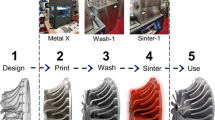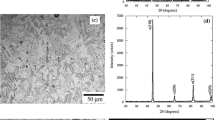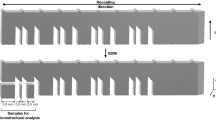Abstract
In applications where a combination of good strength and corrosion resistance is required, 17-4 precipitation hardenable (PH) stainless steel is a common material choice. This alloy is traditionally processed through a combination of casting, rolling, and machining. A variety of heat treatments are used to anneal and harden the material via precipitation strengthening. While additive manufacturing (AM) removes many geometric design constraints from these traditional forming processes, until recently, structures fabricated via laser powder bed fusion (L-PBF) were porous and contained undesirable columnar grain structures that contributed to unpredictable and anisotropic mechanical properties. Recent advances in L-PBF processing technology including improved gas flow, powder atomization, and print parameter optimization enable printing of high-quality 17-4 PH with properties that are comparable to traditionally processed material. However, it is yet to be determined whether these properties can be reliably reproduced across various machines and if machine-agnostic material property baselines can be established based on data available thus far. If baselines can be established, their implementation should allow for identification of machines that generate non-conforming material. In this work, we evaluate the consistency of mechanical properties in L-PBF 17-4 PH produced by six vendors with the ultimate goal of establishing mechanical property baselines, which is fundamental to modern qualification paradigms. We find non-conforming data from two vendors by examining anomalies in mechanical response (e.g., transformation induced plasticity effects) and demonstrate that typical sources of variation can be detected using qualification testing protocols. Ultimately, after standard solution annealing and heat treating, the microstructure and mechanical properties across vendors converged with very few, easily explainable exceptions. In particular, powder atomized in nitrogen promoted formation of retained austenite that lead to a yield point phenomenon in as-built conditions, and high surface roughness from as-built surfaces reduced the fatigue strength. However, with conventional post-processing heat treatments and surface polishing, AM 17-4 PH behaved comparably and consistently to conventionally processed material.





Similar content being viewed by others
References
DebRoy T, Wei HL, Zuback JS, Mukherjee T, Elmer JW, Milewski JO, Beese AM, Wilson-Heid A, De A, Zhang W (2018) Additive manufacturing of metallic components – process, structure and properties. Prog Mater Sci 92:112–224. https://doi.org/10.1016/j.pmatsci.2017.10.001
Jensen SC, Carroll JD, Pathare PR, Saiz DJ, Pegues JW, Boyce BL, Jared BH, Heiden MJ (2023) Long-term process stability in additive manufacturing. Addit Manuf 61:103284. https://doi.org/10.1016/j.addma.2022.103284
Jordan JM (2019) 3D printing. MIT Press, Cambridge
Blakey-Milner B, Gradl P, Snedden G, Brooks M, Pitot J, Lopez E, Leary M, Berto F, du Plessis A (2021) Metal additive manufacturing in aerospace: a review. Mater Des 209:110008. https://doi.org/10.1016/j.matdes.2021.110008
Chen Z, Han C, Gao M, Kandukuri SY, Zhou K (2022) A review on qualification and certification for metal additive manufacturing. Virtual Phys Prototyp 17:382–405. https://doi.org/10.1080/17452759.2021.2018938
SAE International, Machine qualification for fusion-based metal additive manufacturing (AMS7032), (2022).
American Welding Society, Specification for fabrication of metal components using additive manufacturing (AWS D20.1/D20.1M:2019), (2019).
Battelle Memorial Institute, Metallic materials properties development and standardization (MMPDS-14), 14th ed., 2019.
Boyce BL, Salzbrenner BC, Rodelas JM, Swiler LP, Madison JD, Jared BH, Shen Y-L (2017) Extreme-value statistics reveal rare failure-critical defects in additive manufacturing. Adv Eng Mater 19:1700102. https://doi.org/10.1002/adem.201700102
SAE International, AMS 5344: steel castings, investment, corrosion resistant 16Cr - 4.0Ni - 3.1Cu solution and precipitation heat treated, (1963).
Romano S, Brückner-Foit A, Brandão A, Gumpinger J, Ghidini T, Beretta S (2018) Fatigue properties of AlSi10Mg obtained by additive manufacturing: defect-based modelling and prediction of fatigue strength. Eng Fract Mech 187:165–189. https://doi.org/10.1016/j.engfracmech.2017.11.002
Wang L, Zhang Y, Chia HY, Yan W (2022) Mechanism of keyhole pore formation in metal additive manufacturing. Npj Comput Mater 8:22. https://doi.org/10.1038/s41524-022-00699-6
Khairallah SA, Martin AA, Lee JRI, Guss G, Calta NP, Hammons JA, Nielsen MH, Chaput K, Schwalbach E, Shah MN, Chapman MG, Willey TM, Rubenchik AM, Anderson AT, Morris Wang Y, Matthews MJ, King WE (2020) Controlling interdependent meso-nanosecond dynamics and defect generation in metal 3D printing. Science 368:660–665. https://doi.org/10.1126/science.aay7830
Cunningham R, Zhao C, Parab N, Kantzos C, Pauza J, Fezzaa K, Sun T, Rollett AD (2019) Keyhole threshold and morphology in laser melting revealed by ultrahigh-speed X-ray imaging. Science 363:849–852. https://doi.org/10.1126/science.aav4687
Huang Y, Fleming TG, Clark SJ, Marussi S, Fezzaa K, Thiyagalingam J, Leung CLA, Lee PD (2022) Keyhole fluctuation and pore formation mechanisms during laser powder bed fusion additive manufacturing. Nat Commun 13:1–11. https://doi.org/10.1038/s41467-022-28694-x
Yadollahi A, Shamsaei N, Thompson SM, Elwany A, Bian L (2017) Effects of building orientation and heat treatment on fatigue behavior of selective laser melted 17-4 PH stainless steel. Int J Fatigue 94:218–235. https://doi.org/10.1016/j.ijfatigue.2016.03.014
Basu D, Wu Z, Meyer JLL, Larson E, Kuo R, Rollett A (2021) Entrapped gas and process parameter-induced porosity formation in additively manufactured 17-4 PH stainless steel. J Mater Eng Perform 30:5195–5202. https://doi.org/10.1007/s11665-021-05695-3
ASTM International (2022) A705 standard specification for age-hardening stainless steel forgings. https://doi.org/10.1520/A0705_A0705M-22
Facchini L, Vicente N, Lonardelli I, Magalini E, Robotti P, Molinari A (2010) Metastable austenite in 17-4 precipitation-hardening stainless steel produced by selective laser melting. Adv Eng Mater 12:184–188. https://doi.org/10.1002/adem.200900259
Concli F, Fraccaroli L, Nalli F, Cortese L (2022) High and low-cycle-fatigue properties of 17–4 PH manufactured via selective laser melting in as-built, machined and hipped conditions. Prog Addit Manuf 7:99–109. https://doi.org/10.1007/s40964-021-00217-y
Rafi HK, Pal D, Patil N, Starr TL, Stucker BE (2014) Microstructure and mechanical behavior of 17-4 precipitation hardenable steel processed by selective laser melting. J Mater Eng Perform 23:4421–4428. https://doi.org/10.1007/s11665-014-1226-y
LeBrun T, Nakamoto T, Horikawa K, Kobayashi H (2015) Effect of retained austenite on subsequent thermal processing and resultant mechanical properties of selective laser melted 17–4 PH stainless steel. Mater Des 81:44–53. https://doi.org/10.1016/j.matdes.2015.05.026
Mower TM, Long MJ (2016) Mechanical behavior of additive manufactured, powder-bed laser-fused materials. Mater Sci Eng A 651:198–213. https://doi.org/10.1016/j.msea.2015.10.068
Mahmoudi M, Elwany A, Yadollahi A, Thompson SM, Bian L, Shamsaei N (2017) Mechanical properties and microstructural characterization of selective laser melted 17-4 PH stainless steel. Rapid Prototyp J 23:280–294. https://doi.org/10.1108/RPJ-12-2015-0192
Kudzal A, McWilliams B, Hofmeister C, Kellogg F, Yu J, Taggart-Scarff J, Liang J (2017) Effect of scan pattern on the microstructure and mechanical properties of powder bed fusion additive manufactured 17-4 stainless steel. Mater Des 133:205–215. https://doi.org/10.1016/j.matdes.2017.07.047
EOS GmbH, Stainless steel 17-4PH (materials datasheet), (2017).
Pasebani S, Ghayoor M, Badwe S, Irrinki H, Atre SV (2018) Effects of atomizing media and post processing on mechanical properties of 17-4 PH stainless steel manufactured via selective laser melting. Addit Manuf 22:127–137. https://doi.org/10.1016/j.addma.2018.05.011
Nezhadfar PD, Shrestha R, Phan N, Shamsaei N (2019) Fatigue behavior of additively manufactured 17-4 PH stainless steel: synergistic effects of surface roughness and heat treatment. Int J Fatigue 124:188–204. https://doi.org/10.1016/j.ijfatigue.2019.02.039
Yadollahi A, Shamsaei N (2017) Additive manufacturing of fatigue resistant materials: challenges and opportunities. Int J Fatigue 98:14–31. https://doi.org/10.1016/j.ijfatigue.2017.01.001
Bajaj P, Hariharan A, Kini A, Kürnsteiner P, Raabe D, Jagle EA (2020) Steels in additive manufacturing: a review of their microstructure and properties. Mater Sci Eng A 772:138633. https://doi.org/10.1016/j.msea.2019.138633
Zai L, Zhang C, Wang Y, Guo W, Wellmann D, Tong X, Tian Y (2020) Laser powder bed fusion of precipitation-hardened martensitic stainless steels: a review. Metals (Basel) 10:255. https://doi.org/10.3390/met10020255
Murr LE, Martinez E, Hernandez J, Collins S, Amato KN, Gaytan SM, Shindo PW (2012) Microstructures and properties of 17-4 PH stainless steel fabricated by selective laser melting. J Mater Res Technol 1:167–177. https://doi.org/10.1016/S2238-7854(12)70029-7
ASTM International (2021) E8/E8M standard test methods for tension testing of metallic materials. Annu B ASTM Stand:1–27. https://doi.org/10.1520/E0008
ASTM International (2019) A564-19a: standard specification for hot-rolled and cold-finished age-hardening stainless steel bars and shapes. https://doi.org/10.1520/A0564
AlMangour B, Yang J-M (2016) Improving the surface quality and mechanical properties by shot-peening of 17-4 stainless steel fabricated by additive manufacturing. Mater Des 110:914–924. https://doi.org/10.1016/j.matdes.2016.08.037
Shaffer DJ, Wilson-Heid AE, Keist JS, Beese AM, Palmer TA (2021) Impact of retained austenite on the aging response of additively manufactured 17-4 PH grade stainless steel. Mater Sci Eng A 817:141363. https://doi.org/10.1016/j.msea.2021.141363
Meredith SD, Zuback JS, Keist JS, Palmer TA (2018) Impact of composition on the heat treatment response of additively manufactured 17–4 PH grade stainless steel. Mater Sci Eng A 738:44–56. https://doi.org/10.1016/j.msea.2018.09.066
Lass EA, Stoudt MR, Williams ME (2019) Additively manufactured nitrogen-atomized 17-4 PH stainless steel with mechanical properties comparable to wrought. Metall Mater Trans A 50:1619–1624. https://doi.org/10.1007/s11661-019-05124-0
Ansys Inc., Granta materials database, (n.d.).
Witkin DB, Patel D, Albright TV, Bean GE, McLouth T (2020) Influence of surface conditions and specimen orientation on high cycle fatigue properties of Inconel 718 prepared by laser powder bed fusion. Int J Fatigue 132:105392. https://doi.org/10.1016/j.ijfatigue.2019.105392
Funding
This material is based upon work funded by the Naval Sea Systems Command (NAVSEA) under contract N00024-13-D-6400. The authors would like to thank Cavin Mooers and Andy Lennon from JHU/APL for assistance with supplemental work and helpful discussions.
Author information
Authors and Affiliations
Contributions
All authors contributed to the study conception and design. The first draft of the manuscript was written by Denise Yin, Edwin Gienger, and Brendan Croom.
Corresponding author
Ethics declarations
Competing interests
The authors declare no competing interests.
Additional information
Publisher’s note
Springer Nature remains neutral with regard to jurisdictional claims in published maps and institutional affiliations.
Rights and permissions
Springer Nature or its licensor (e.g. a society or other partner) holds exclusive rights to this article under a publishing agreement with the author(s) or other rightsholder(s); author self-archiving of the accepted manuscript version of this article is solely governed by the terms of such publishing agreement and applicable law.
About this article
Cite this article
Yin, D., Gienger, E.B., Croom, B.P. et al. Variability in mechanical properties of additively manufactured 17-4 PH stainless steel produced by multiple vendors: insights for qualification. Int J Adv Manuf Technol 128, 3093–3103 (2023). https://doi.org/10.1007/s00170-023-12113-6
Received:
Accepted:
Published:
Issue Date:
DOI: https://doi.org/10.1007/s00170-023-12113-6




